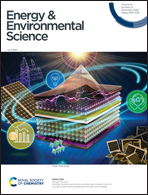Bottom-up modification boosts the performance of narrow-bandgap lead–tin perovskite single-junction and tandem solar cells†
Abstract
Mixed lead and tin (Pb–Sn) halide perovskites are highly promising because of their narrow bandgaps and potential for all-perovskite tandem solar cell applications. Despite achieving decent power conversion efficiencies (PCEs) thus far, Pb–Sn perovskite solar cells still have faced challenges such as easy oxidation of Sn2+ to Sn4+, resulting in abundant defects in the body and interfaces. In this study, we adopt a feasible and low-cost modification material, i.e. glycine hydrochloride (GlyCl), into Pb–Sn perovskite solar cells from bottom to up. The GlyCl modification agent was incorporated into the bottom poly(3,4-ethylenedioxythiophene) polystyrene sulfonate hole transporting layers, middle perovskite absorbers, and top capping layers, significantly passivating defects across multiple channels. Additionally, the introduction of GlyCl improved carrier transport, suppressed the oxidation of Sn2+ to Sn4+, and reacted with residual lead iodide on the top of perovskite films. Consequently, Pb–Sn halide perovskite solar cells employing multiple GlyCl modifications achieved the highest PCE of 22.07%, with a markedly improved open-circuit voltage and fill factor, which enabled efficient 4-terminal all-perovskite tandem solar cells with a maximum PCE of 27.07%. This work sheds light on the importance of multi-channel passivation for narrow-bandgap Pb–Sn perovskite solar cells and tandem cells.



 Please wait while we load your content...
Please wait while we load your content...